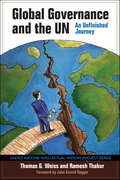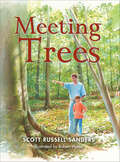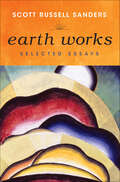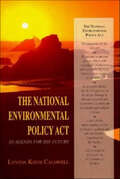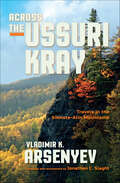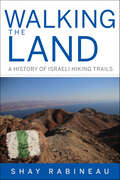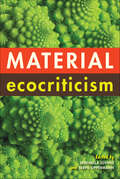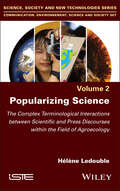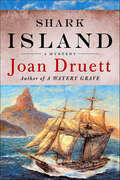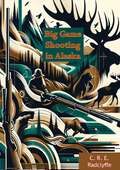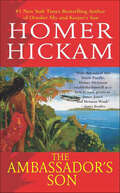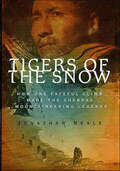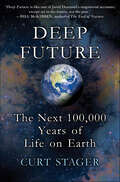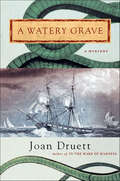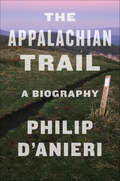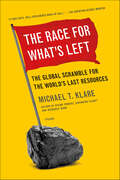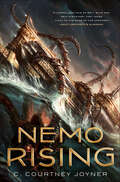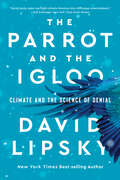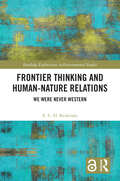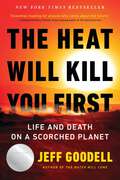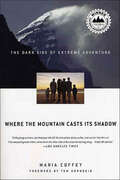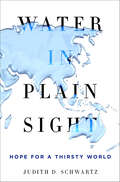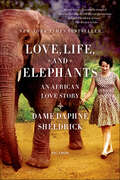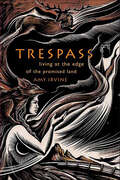- Table View
- List View
Global Governance and the UN: An Unfinished Journey (United Nations Intellectual History Project Series)
by Thomas G. Weiss Ramesh ThakurIn the 21st century, the world is faced with threats of global scale that cannot be confronted without collective action. Although global government as such does not exist, formal and informal institutions, practices, and initiatives—together forming "global governance"—bring a greater measure of predictability, stability, and order to trans-border issues than might be expected. Yet, there are significant gaps between many current global problems and available solutions. Thomas G. Weiss and Ramesh Thakur analyze the UN's role in addressing such knowledge, normative, policy, institutional, and compliance lapses. The UN's relationship to these five global governance gaps is explored through case studies of some of the most burning problems of our age, including terrorism, nuclear proliferation, humanitarian crises, development aid, climate change, human rights, and HIV/AIDS.
Understanding Climate Change through Religious Lifeworlds
by David L. HabermanHow can religion help to understand and contend with the challenges of climate change?Understanding Climate Change through Religious Lifeworld,edited by David Haberman, presents a unique collection of essays that detail how the effects of human-related climate change are actively reshaping religious ideas and practices, even as religious groups and communities endeavor to bring their traditions to bear on mounting climate challenges.People of faith from the low-lying islands of the South Pacific to the glacial regions of the Himalayas are influencing how their communities understand earthly problems and develop meaningful responses to them. This collection focuses on a variety of different aspects of this critical interaction, including the role of religion in ongoing debates about climate change, religious sources of environmental knowledge and how this knowledge informs community responses to climate change, and the ways that climate change is in turn driving religious change.Understanding Climate Change through Religious Lifeworlds offers a transnational view of how religion reconciles the concepts of the global and the local and influences the challenges of climate change.
Meeting Trees
by Scott Russell SandersYoung Scott and his father have a personal way of learning the trees and remembering their names. It's a game they like to play, one you'll want to play too!Learn the name of the swallowtail butterfly who loves to sit on the dogwood branch, see the majestic beauty of the black-and-yellow Argiope spider, or see what makes the beech tree so special (its bark is smooth and gray just like the skin of a hippo).Featuring beautiful paintings by nature artist Robert Hynes and the exquisite language of renowned author Scott Russell Sanders, Meeting Trees captures the delicate details of bark, branches, and leaves while enchanting readers with the beauty of the natural world.
Earth Works: Selected Essays
by Scott Russell SandersIn the hands of award-winning writer Scott Russell Sanders, the essay becomes an inquisitive and revelatory form of art. In 30 of his finest essays—nine never before collected—Sanders examines his Midwestern background, his father's drinking, his opposition to war, his literary inheritance, and his feeling for wildness. He also tackles such vital issues as the disruption of Earth's climate, the impact of technology, the mystique of money, the ideology of consumerism, and the meaning of sustainability. Throughout, he asks perennial questions: What is a good life? How do family and culture shape a person's character? How should we treat one another and the Earth? What is our role in the cosmos? Readers and writers alike will find wisdom and inspiration in Sanders's luminous and thought-provoking prose.
The National Environmental Policy Act: An Agenda for the Future
by Lynton Keith Caldwell"The National Environmental Policy Act has grown more, not less, important in the decades since its enactment. No one knows more about NEPA than Lynton Caldwell. And no one has a clearer vision of its relevance to our future. Highly recommended." —David W. Orr, Oberlin CollegeWhat has been achieved since the National Environmental Policy Act was passed in 1969? This book points out where and how NEPA has affected national environmental policy and where and why its intent has been frustrated. The roles of Congress, the President, and the courts in the implementation of NEPA are analyzed. Professor Caldwell also looks at the conflicted state of public opinion regarding the environment and conjectures as to what must be done in order to develop a coherent and sustained policy.
Across the Ussuri Kray: Travels in the Sikhote-Alin Mountains
by Vladimir K. ArsenyevIn Russia's Far East sits the wild Ussuri Kray, a region known for its remote highlands and rugged mountain passes where tigers and bears roam the cliffs, and salmon and lenok navigate the rivers. In this collection of travel writing by famed Russian explorer and naturalist Vladimir K. Arsenyev (1872-1930), readers are shuttled back to the turn of the 20th century when the Russian Empire was reeling from its defeat in the Russo-Japanese War (1904-1905) and vulnerable to its Far Eastern neighbors. What began as an expedition to survey the region's infrastructure for the Russian military turned into an adventure through a territory rich in ethnic and ecological diversity. Encountering the disappearing indigenous cultures of the Nanai and Udege, engaging the help of Korean farmers and Chinese hunters, and witnessing the beginning of indomitable Russian settlement, Arsenyev documents the lives and customs of the region's inhabitants and their surroundings. Originally written as "a popular scientific description of the Kray," this unabridged edition includes photographs largely unseen for nearly a century and is annotated by Jonathan C. Slaght, a biologist working in the same forests Arsenyev explored. Across the Ussuri Kray is a classic of northeast Asian cultural and natural history.
Walking the Land: A History of Israeli Hiking Trails (Perspectives on Israel Studies)
by Shay RabineauIsrael has one of the most extensive and highly developed hiking trail systems of any country in the world. Millions of hikers use the trails every year during holiday breaks, on mandatory school trips, and for recreational hikes. Walking the Land offers the first scholarly exploration of this unique trail system. Featuring more than ten thousand kilometers of trails, marked with hundreds of thousands of colored blazes, the trail system crisscrosses Israeli-controlled territory, from the country's farthest borders to its densest metropolitan areas. The thousand-kilometer Israel National Trail crosses the country from north to south. Hiking, trails, and the ubiquitous three-striped trail blazes appear everywhere in Israeli popular culture; they are the subjects of news articles, radio programs, television shows, best-selling novels, government debates, and even national security speeches. Yet the trail system is almost completely unknown to the millions of foreign tourists who visit every year and has been largely unstudied by scholars of Israel. Walking the Land explores the many ways that Israel's hiking trails are significant to its history, national identity, and conservation efforts.
Material Ecocriticism
by Serenella Iovino Serpil OppermannMaterial Ecocriticism offers new ways to analyze language and reality, human and nonhuman life, mind and matter, without falling into well-worn paths of thinking. Bringing ecocriticism closer to the material turn, the contributions to this landmark volume focus on material forces and substances, the agency of things, processes, narratives and stories, and making meaning out of the world. This broad-ranging reflection on contemporary human experience and expression provokes new understandings of the planet to which we are intimately connected.
Popularizing Science: The Complex Terminological Interactions between Scientific and Press Discourses within the Field of Agroecology
by Hélène LedoubleMedia coverage of scientific issues is a highly complex process. It involves making a specialized field accessible to the general public, without necessarily disseminating the associated scientific terms or knowledge. The terminological interactions between press discourses and scientific knowledge are presented within the field of agroecology. The analysis of textual data focuses on articles in the general press in French and English, devoted to plant protection practices using natural mechanisms (biological control). This book provides a terminological and cognitive overview of the issues involved in popularizing science in a rapidly expanding field, and of the challenges to be met in the constantly evolving environmental communication sector.
Shark Island: A Mystery (Wiki Coffin Mysteries #2)
by Joan DruettWiki Coffin, linguist aboard the U.S. Exploring Expedition, the famous voyage meant to put America at the forefront of 19th century scientific discovery, brings many skills to his job. Whether he's translating native languages, assisting his good friend Captain George Rochester as unofficial first mate, or upholding the rule of law as deputy to the sheriff of the port of Virginia, Wiki is never far from the action aboard the seven ships that make up the expedition.But when they encounter a wrecked sealing ship and its desperate crew on the shoals of remote, uninhabited Shark Island, Wiki has little idea just how many of his skills are about to be put to the test. As soon as they board the wreck, a dead body turns up with a dagger firmly inserted between its shoulder blades. And it's not just any dead body: the victim of the brutal murder is none other than the enigmatic captain of the doomed voyage. What's more, Wiki's colleague and nemesis Lieutenant Forsythe is suspected of the crime.Knowing full well that Forsythe is capable of such violence, Wiki nonetheless believes him innocent and is duty-bound to prove it for the good of the expedition. Was the murder a case of mutinous sealers taking the law into their own hands? Did the secrets of several mysterious long-ago voyages finally come back to haunt a dishonest and dishonorable captain? Or is Shark Island home to something more sinister than a few lonely goats? Something isn't quite right about the crew of the wrecked ship, and Wiki will stop at nothing to find out just what it is that they're hiding, and, in the process, unmask a vicious killer.
Big Game Shooting in Alaska
by C. R. E. RadclyffeEmbark on a thrilling adventure through the rugged wilderness of Alaska with C. R. E. Radclyffe's Big Game Shooting in Alaska. This captivating account provides an exhilarating glimpse into the world of big game hunting at the turn of the 20th century, offering readers a front-row seat to the challenges and triumphs of tracking and hunting some of the most majestic creatures in the Alaskan frontier.C. R. E. Radclyffe, an experienced hunter and storyteller, shares his firsthand experiences of hunting in one of the world’s most remote and untamed landscapes. Through vivid and engaging narrative, Radclyffe brings to life the breathtaking beauty and harsh realities of the Alaskan wilderness, capturing the essence of the hunt and the spirit of adventure that drives it.Big Game Shooting in Alaska delves into the pursuit of various big game species, including moose, caribou, grizzly bear, and mountain goat. Radclyffe provides detailed descriptions of the hunting techniques, equipment, and strategies employed, as well as the physical and mental stamina required to navigate the challenging terrain and extreme weather conditions.The book also offers insights into the natural history and behavior of the animals, enriching the reader’s understanding of the intricate dynamics between hunter and prey. Radclyffe's respect for the wildlife and the environment shines through, emphasizing the importance of ethical hunting practices and conservation.Big Game Shooting in Alaska is an essential read for hunting enthusiasts, outdoor adventurers, and anyone fascinated by the untamed beauty of Alaska. C. R. E. Radclyffe’s masterful storytelling and keen observations make this book a timeless classic, celebrating the spirit of adventure and the enduring allure of the wild.
The Ambassador's Son (Josh Thurlow #2)
by Homer HickamIt's 1943 and the Americans and Japanese are fighting a deadly war in the hot, jungle-covered volcanic islands of the South Pacific. The outcome is in doubt and a terrible blow has fallen on American morale. Lieutenant David Armistead, a Marine Corps hero and cousin of the President of the United States, is missing and some say he's gone over to the enemy. Coast Guard Captain Josh Thurlow and his ragtag crew are given the assignment to find Armistead, though not necessarily to bring him back alive. Recruited in the hunt is a tormented and frail PT-boat skipper nicknamed "Shafty" who is also known by another name: John F. Kennedy. When Josh is stranded in the jungles of New Georgia with a mysterious, sensual woman who has a tendency to chop off men's heads, it's up to Kennedy to come to the rescue and complete the mission. But to procure a gunboat, he first has to play high-stakes poker with a young naval supply officer called Nick who happens to be the best gambler in the South Pacific. Nick has another name, too: Richard M. Nixon. Based solidly on historical fact with echoes of James Michener, The Ambassador'sSon is a thrilling tale of the South Pacific and adventure fiction at its finest.
Tigers of the Snow: How One Fateful Climb Made the Sherpas Mountaineering Legends
by Jonathan NealeTigers of the Snow is true story of the tragedy and survival on one of the world's most dangerous mountains.In 1922 Himalayan climbers were British gentlemen, and their Sherpa and Tibetan porters were "coolies," unskilled and inexperienced casual laborers. By 1953 Sherpa Tenzing Norgay stood on the summit of Everest, and the coolies had become the "Tigers of the Snow."Jonathan Neale's absorbing book is both a compelling history of the oft-forgotten heroes of mountaineering and a gripping account of the expedition that transformed the Sherpas into climbing legends. In 1934 a German-led team set off to climb the Himalayan peak of Nanga Parbat, the ninth highest mountain on earth. After a disastrous assault in 1895, no attempt had been made to conquer the mountain for thirty-nine years. The new Nazi government was determined to prove German physical superiority to the rest of the world. A heavily funded expedition was under pressure to deliver results. Like all climbers of the time, they did not really understand what altitude did to the human body. When a hurricane hit the leading party just short of the summit, the strongest German climbers headed down and left the weaker Germans and the Sherpas to die on the ridge. What happened in the next few days of death and fear changed forever how the Sherpa climbers thought of themselves. From that point on, they knew they were the decent and responsible people of the mountain.Jonathan Neale interviewed many old Sherpa men and women, including Ang Tsering, the last man off Nanga Parbat alive in 1934. Impeccably researched and superbly written, Tigers of the Snow is the compelling narrative of a climb gone wrong, set against the mountaineering history of the early twentieth century, the haunting background of German politics in the 1930s, and the hardship and passion of life in the Sherpa valleys.
Deep Future: The Next 100,000 Years of Life on Earth
by Curt StagerA Kirkus Reviews Best Nonfiction of 2011 title A bold, far-reaching look at how our actions will decide the planet's future for millennia to come.Imagine a planet where North American and Eurasian navies are squaring off over shipping lanes through an acidified, ice-free Arctic. Centuries later, their northern descendants retreat southward as the recovering sea freezes over again. And later still, future nations plan how to avert an approaching Ice Age... by burning what remains of our fossil fuels.These are just a few of the events that are likely to befall Earth and human civilization in the next 100,000 years. And it will be the choices we make in this century that will affect that future more than those of any previous generation. We are living at the dawn of the Age of Humans; the only question is how long that age will last.Few of us have yet asked, "What happens after global warming?" Drawing upon the latest, groundbreaking works of a handful of climate visionaries, Curt Stager's Deep Future helps us look beyond 2100 a.d. to the next hundred millennia of life on Earth.
A Watery Grave: A Mystery (Wiki Coffin Mysteries #1)
by Joan DruettThe year is 1838, and after more than ten years in the planning, the famous United States Exploring Expedition is set to launch into uncharted waters from the coast of Virginia. A convoy of seven ships filled with astronomers, mapmakers, naturalists, and the sailors charged with getting them around the world, the "Ex. Ex." is finally underway, with much fanfare.Aboard the convoy as ship's linguist is Wiki Coffin. Half New Zealand Maori and half American, Wiki speaks numerous languages and is expected to help the crew navigate the Pacific islands that are his native heritage. But just before departure Wiki, subject to the unfortunate bigotry of the time, is arrested for a vicious murder he didn't commit.The convoy sails off, but just before the ships are out of reach Wiki is exonerated, set free to catch up with his ship and sail on. The catch: the local sheriff is convinced that the real murderer is aboard one of the seven ships of the expedition, and Wiki is deputized to identify the killer and bring him to justice. Full of the evocative maritime detail and atmosphere that have won her numerous awards for her nonfiction, Joan Druett's A Watery Grave is the mystery debut of a masterful maritime writer.
The Appalachian Trail: A Biography
by Philip D'AnieriThe Appalachian Trail is America&’s most beloved trek, with millions of hikers setting foot on it every year. Yet few are aware of the fascinating backstory of the dreamers and builders who helped bring it to life over the past century. The conception and building of the Appalachian Trail is a story of unforgettable characters who explored it, defined it, and captured national attention by hiking it. From Grandma Gatewood—a mother of eleven who thru-hiked in canvas sneakers and a drawstring duffle—to Bill Bryson, author of the best-selling A Walk in the Woods, the AT has seized the American imagination like no other hiking path. The 2,000-mile-long hike from Georgia to Maine is not just a trail through the woods, but a set of ideas about nature etched in the forest floor. This character-driven biography of the trail is a must-read not just for ambitious hikers, but for anyone who wonders about our relationship with the great outdoors and dreams of getting away from urban life for a pilgrimage in the wild.
The Race for What's Left: The Global Scramble for the World's Last Resources
by Michael T. KlareFrom Michael Klare, the renowned expert on natural resource issues, an invaluable account of a new and dangerous global competitionThe world is facing an unprecedented crisis of resource depletion—a crisis that goes beyond "peak oil" to encompass shortages of coal and uranium, copper and lithium, water and arable land. With all of the planet's easily accessible resource deposits rapidly approaching exhaustion, the desperate hunt for supplies has become a frenzy of extreme exploration, as governments and corporations rush to stake their claim in areas previously considered too dangerous and remote. The Race for What's Left takes us from the Arctic to war zones to deep ocean floors, from a Russian submarine planting the country's flag on the North Pole seabed to the large-scale buying up of African farmland by Saudi Arabia, China, and other food-importing nations.As Klare explains, this invasion of the final frontiers carries grave consequences. With resource extraction growing more complex, the environmental risks are becoming increasingly severe; the Deepwater Horizon disaster is only a preview of the dangers to come. At the same time, the intense search for dwindling supplies is igniting new border disputes, raising the likelihood of military confrontation. Inevitably, if the scouring of the globe continues on its present path, many key resources that modern industry relies upon will disappear completely. The only way out, Klare argues, is to alter our consumption patterns altogether—a crucial task that will be the greatest challenge of the coming century.
Nemo Rising
by C. Courtney JoynerAn exciting sequel to the Captain Nemo adventures enjoyed by millions in Jules Verne's 20,000 Leagues Under the Sea.Sea monsters are sinking ships up and down the Atlantic Coast. Enraged that his navy is helpless against this onslaught and facing a possible World War as a result, President Ulysses S. Grant is forced to ask for assistance from the notorious Captain Nemo, in Federal prison for war crimes and scheduled for execution. Grant returns Nemo’s submarine, the infamous Victorian Steampunk marvel Nautilus, and promises a full Presidential pardon if Nemo hunts down and destroys the source of the attacks. Accompanied by the beautiful niece of Grant’s chief advisor, Nemo sets off under the sea in search of answers. Unfortunately, the enemy may be closer than they realize...At the Publisher's request, this title is being sold without Digital Rights Management Software (DRM) applied.
The Parrot and the Igloo: Climate And The Science Of Denial
by David LipskyA New York Times Editors’ Choice Named a Best Book of the Year in The New Yorker, Publishers Weekly, Chicago Tribune, and EcoLit Books A USA Today Must-Read Summer Book "David Lipsky spins top-flight climate literature into cliffhanger entertainment." —Zoë Schlanger, New York Times Book Review The New York Times best-selling author explores how “anti-science” became so virulent in American life—through a history of climate denial and its consequences. In 1956, the New York Times prophesied that once global warming really kicked in, we could see parrots in the Antarctic. In 2010, when science deniers had control of the climate story, Senator James Inhofe and his family built an igloo on the Washington Mall and plunked a sign on top: AL GORE'S NEW HOME: HONK IF YOU LOVE CLIMATE CHANGE. In The Parrot and the Igloo, best-selling author David Lipsky tells the astonishing story of how we moved from one extreme (the correct one) to the other. With narrative sweep and a superb eye for character, Lipsky unfolds the dramatic narrative of the long, strange march of climate science. The story begins with a tale of three inventors—Thomas Edison, George Westinghouse, and Nikola Tesla—who made our technological world, not knowing what they had set into motion. Then there are the scientists who sounded the alarm once they identified carbon dioxide as the culprit of our warming planet. And we meet the hucksters, zealots, and crackpots who lied about that science and misled the public in ever more outrageous ways. Lipsky masterfully traces the evolution of climate denial, exposing how it grew out of early efforts to build a network of untruth about products like aspirin and cigarettes. Featuring an indelible cast of heroes and villains, mavericks and swindlers, The Parrot and the Igloo delivers a real-life tragicomedy—one that captures the extraordinary dance of science, money, and the American character.
Frontier Thinking and Human-Nature Relations: We Were Never Western (Routledge Explorations in Environmental Studies)
by E. C. KeskitaloCombining historical, social and regulative analysis, this book builds a compelling critique of ‘frontier thinking’ as it continues to form our assumptions about social and environmental organisation – in ways that impact not least the present environmental crisis.This book systematically identifies the ways in which images of nature and society are formed by the historically developed frontier-oriented narratives which have underpinned much Anglo-American and Anglocentric thought. The book confronts these conceptions at large, showing that they never held empirically, and contrasts them with the situation in northern Europe, where diverging assumptions are integral to this day. Through this juxtaposition, this book illustrates not only the pervasiveness of structures of understanding in steering policy but also the varying traditions regarding how understandings of the environment can be formed.This study highlights how historical thought patterns, formed for very different reasons than exist today, continue to shape our assumptions about nature, the relation between urban and rural areas and our understanding of ourselves in relation to the environment. This book will be of wide interest to a range of academics and students in the fields of geography, anthropology, environmental studies, sociology, political science and development studies, amongst others.
The Heat Will Kill You First: Life and Death on a Scorched Planet
by Jeff GoodellNew York Times best-selling journalist Jeff Goodell presents a "masterful, bracing" (David Wallace-Wells) examination of the impact that temperature rise will have on our lives and on our planet, offering a vital new perspective on where we are headed, how we can prepare, and what is at stake if we fail to act. &“When heat comes, it&’s invisible. It doesn&’t bend tree branches or blow hair across your face to let you know it&’s arrived…. The sun feels like the barrel of a gun pointed at you.&” The world is waking up to a new reality: wildfires are now seasonal in California, the Northeast is getting less and less snow each winter, and the ice sheets in the Arctic and Antarctica are melting fast. Heat is the first order threat that drives all other impacts of the climate crisis. And as the temperature rises, it is revealing fault lines in our governments, our politics, our economy, and our values. The basic science is not complicated: Stop burning fossil fuels tomorrow, and the global temperature will stop rising tomorrow. Stop burning fossil fuels in 50 years, and the temperature will keep rising for 50 years, making parts of our planet virtually uninhabitable. It&’s up to us. The hotter it gets, the deeper and wider our fault lines will open. The Heat Will Kill You First is about the extreme ways in which our planet is already changing. It is about why spring is coming a few weeks earlier and fall is coming a few weeks later and the impact that will have on everything from our food supply to disease outbreaks. It is about what will happen to our lives and our communities when typical summer days in Chicago or Boston go from 90° F to 110°F. A heatwave, Goodell explains, is a predatory event— one that culls out the most vulnerable people. But that is changing. As heatwaves become more intense and more common, they will become more democratic. As an award-winning journalist who has been at the forefront of environmental journalism for decades, Goodell&’s new book may be his most provocative yet, explaining how extreme heat will dramatically change the world as we know it. Masterfully reported, mixing the latest scientific insight with on-the-ground storytelling, Jeff Goodell tackles the big questions and uncovers how extreme heat is a force beyond anything we have reckoned with before.
Where the Mountain Casts Its Shadow: The Dark Side of Extreme Adventure
by Maria CoffeyMaria Coffey's Where the Mountain Casts Its Shadow is a powerful, affecting and important book that exposes the far reaching personal costs of extreme adventure.Without risk, say mountaineers, there would be none of the self-knowledge that comes from pushing life to its extremes. For them, perhaps, it is worth the cost. But when tragedy strikes, what happens to the people left behind? Why would anyone choose to invest in a future with a high-altitude risk-taker? What is life like in the shadow of the mountain? Such questions have long been taboo in the world of mountaineering. Now, the spouses, parents and children of internationally renowned climbers finally break their silence, speaking out about the dark side of adventure.Maria Coffey confronted one of the harshest realities of mountaineering when her partner Joe Tasker disappeared on the Northeast Ridge of Everest in 1982. In Where the Mountain Casts Its Shadow, Coffey offers an intimate portrait of adventure and the conflicting beauty, passion, and devastation of this alluring obsession. Through interviews with the world's top climbers, or their widows and families-Jim Wickwire, Conrad Anker, Lynn Hill, Joe Simpson, Chris Bonington, Ed Viesturs, Anatoli Boukreev, Alex Lowe, and many others-she explores what compels men and women to give their lives to the high mountains. She asks why, despite the countless tragedies, the world continues to laud their exploits.With an insider's understanding, Coffey reveals the consequences of loving people who pursue such risk-the exhilarating highs and inevitable lows, the stress of long separations, the constant threat of bereavement, and the lives shattered in the wake of climbing accidents.
Water in Plain Sight: Hope for a Thirsty World
by Judith D. SchwartzWater scarcity is on everyone's mind. Long taken for granted, water availability has entered the realm of economics, politics, and people's food and lifestyle choices. But as anxiety mounts - even as a swath of California farmland has been left fallow and extremist groups worldwide exploit the desperation of people losing livelihoods to desertification - many are finding new routes to water security with key implications for food access, economic resilience, and climate change.Water does not perish, nor require millions of years to form as do fossil fuels. However, water is always on the move. In this timely, important book, Judith D. Schwartz presents a refreshing perspective on water that transcends zero-sum thinking. By allying with the water cycle, we can revive lush, productive landscapes. Like the river in rural Zimbabwe that, thanks to restorative grazing, now flows miles further than in living memory. Or the food forest of oranges, pomegranates, and native fruit-bearing plants in Tucson, grown through harvesting urban wastewater. Or the mini-oasis in West Texas nourished by dew.Animated by stories from around the globe, Water In Plain Sight is an inspiring reminder that fixing the future of our drying planet involves understanding what makes natural systems thrive.
Love, Life, and Elephants: An African Love Story
by Daphne SheldrickDaphne Sheldrick, whose family arrived in Africa from Scotland in the 1820s, is the first person ever to have successfully hand-reared newborn elephants. Her deep empathy and understanding, her years of observing Kenya's rich variety of wildlife, and her pioneering work in perfecting the right husbandry and milk formula have saved countless elephants, rhinos, and other baby animals from certain death. In this heartwarming and poignant memoir, Daphne shares her amazing relationships with a host of orphans, including her first love, Bushy, a liquid-eyed antelope; Rickey-Tickey-Tavey, the little dwarf mongoose; Gregory Peck, the busy buffalo weaver bird; Huppety, the mischievous zebra; and the majestic elephant Eleanor, with whom Daphne has shared more than forty years of great friendship. But this is also a magical and heartbreaking human love story between Daphne and David Sheldrick, the famous Tsavo Park warden. It was their deep and passionate love, David's extraordinary insight into all aspects of nature, and the tragedy of his early death that inspired Daphne's vast array of achievements, most notably the founding of the world-renowned David Sheldrick Wildlife Trust and the Orphans' Nursery in Nairobi National Park, where Daphne continues to live and work to this day. Encompassing not only David and Daphne's tireless campaign for an end to poaching and for conserving Kenya's wildlife, but also their ability to engage with the human side of animals and their rearing of the orphans expressly so they can return to the wild, Love, Life, and Elephants is alive with compassion and humor, providing a rare insight into the life of one of the world's most remarkable women.
Trespass: Living at the Edge of the Promised Land
by Amy IrvineTrespass is the story of one woman's struggle to gain footing in inhospitable territory. A wilderness activist and apostate Mormon, Amy Irvine sought respite in the desert outback of southern Utah's red-rock country after her father's suicide, only to find out just how much of an interloper she was among her own people. But more than simply an exploration of personal loss, Trespass is an elegy for a dying world, for the ruin of one of our most beloved and unique desert landscapes and for our vanishing connection to it. Fearing what her father's fate might somehow portend for her, Irvine retreated into the remote recesses of the Colorado Plateau—home not only to the world's most renowned national parks but also to a rugged brand of cowboy Mormonism that stands in defiant contrast to the world at large. Her story is one of ruin and restoration, of learning to live among people who fear the wilderness the way they fear the devil and how that fear fuels an antagonism toward environmental concerns that pervades the region. At the same time, Irvine mourns her own loss of wildness and disconnection from spirituality, while ultimately discovering that the provinces of nature and faith are not as distinct as she once might have believed.
